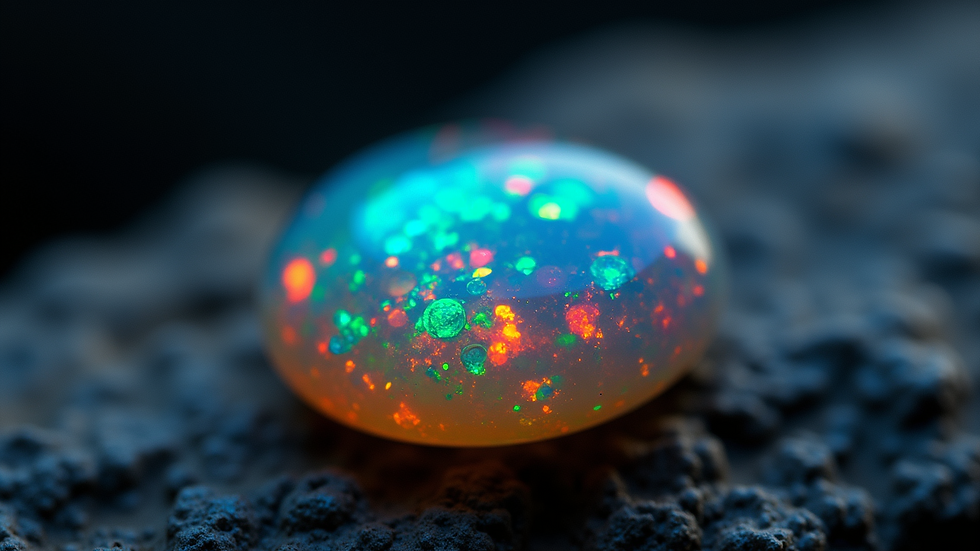Ethiopian Opal Cabochons: Features and Appeal
- Main manager Contact | Th.M.V

- 3 days ago
- 4 min read
The world of gemstones is vast and endlessly fascinating, but few stones capture the imagination quite like Ethiopian opal gems. Their fiery play of colours, mysterious origins, and unique characteristics make them a treasure for collectors, jewelers, and enthusiasts alike. When I first encountered these gems, I was instantly captivated by their vibrant hues and the stories they seemed to whisper. Today, I want to take you on a journey through the enchanting realm of Ethiopian opal cabochons, revealing their features, appeal, and why they deserve a special place in your collection or jewellery line.
Discovering the Magic of Ethiopian Opal Gems
Ethiopian opal gems are unlike any other opals you might have seen. Found primarily in the Wollo and Shewa regions of Ethiopia, these stones burst with a kaleidoscope of colours that dance and shimmer with every movement. What sets them apart is not just their vivid palette but their origin story - mined from volcanic rock formations, these opals carry the essence of ancient geological processes.
The allure of Ethiopian opal gems lies in their play-of-colour - a phenomenon where flashes of red, green, blue, and orange flicker across the stone’s surface. This optical spectacle is caused by the diffraction of light within the microscopic silica spheres that compose the opal. The larger and more uniform these spheres, the more intense and varied the colours.
But there’s more to these gems than just their visual appeal. Their formation in volcanic ash layers means they often have a unique translucency and a lighter body tone compared to traditional Australian opals. This gives them a delicate, almost ethereal glow that is simply mesmerizing.

Why Ethiopian Opal Gems Are a Jeweller’s Dream
For those in the jewellery trade, Ethiopian opal gems offer a rare combination of beauty, versatility, and ethical sourcing. At Gems Creation Arts (GCA), we pride ourselves on providing certified, ethically sourced gemstones that meet the highest standards of quality and integrity. Ethiopian opals fit perfectly into this vision.
One of the most exciting aspects of these gems is their adaptability. Whether set in rings, pendants, earrings, or bespoke pieces, their fiery colours complement a wide range of metals and designs. The cabochon cut, in particular, enhances the stone’s natural play-of-colour by creating a smooth, domed surface that catches light from every angle.
Moreover, Ethiopian opal gems are relatively affordable compared to other precious stones with similar visual impact. This makes them an excellent choice for wholesale buyers looking to offer something unique and eye-catching without breaking the bank.
Here are some practical tips for jewellers working with Ethiopian opal gems:
Choose the right setting: Because opals are softer than many other gemstones, protective settings like bezels help prevent damage.
Highlight the colour: Use simple, elegant designs that allow the opal’s natural beauty to shine.
Educate customers: Share the story of the stone’s origin and ethical sourcing to add value and appeal.

The Unique Characteristics of Ethiopian Opal Cabochons
When I speak of ethiopian opal cabochons, I refer to a specific style of gemstone cutting that perfectly suits the nature of opals. Unlike faceted stones, cabochons have a smooth, rounded surface without sharp edges. This cut is ideal for showcasing the opal’s play-of-colour and enhancing its natural glow.
Ethiopian opal cabochons often exhibit a range of body tones from milky white to translucent, sometimes even with a honey or peach tint. This variety adds to their charm and allows for diverse design possibilities.
Another fascinating feature is the presence of hydrophane opals among Ethiopian varieties. These stones can absorb water, temporarily changing their transparency and colour intensity. Imagine a gem that transforms before your eyes - it’s like holding a living piece of art!
However, this characteristic also means that care is essential. Hydrophane opals should be kept away from prolonged exposure to water or harsh chemicals to maintain their beauty and durability.
How to Care for Your Ethiopian Opal Gems
Owning Ethiopian opal gems is a joy, but it comes with responsibility. These stones are relatively soft, ranking about 5.5 to 6.5 on the Mohs hardness scale, which means they can scratch or chip if not handled carefully.
Here are some actionable recommendations to keep your opals looking radiant:
Avoid harsh chemicals: Perfumes, cleaning agents, and even some lotions can damage the stone’s surface.
Store separately: Keep opals in soft pouches or lined jewellery boxes to prevent scratches from harder gems.
Clean gently: Use a soft, damp cloth and mild soap if necessary. Avoid ultrasonic cleaners or steamers.
Limit exposure: Prolonged sunlight or extreme temperature changes can cause cracking or colour fading.
By following these simple steps, you ensure that your Ethiopian opal gems remain as stunning as the day you acquired them.
Why Gems Creation Arts (GCA) Is Your Trusted Source for Ethiopian Opal Gems
In a market flooded with options, trust and quality are paramount. Gems Creation Arts (GCA) stands out as a beacon of excellence and ethical sourcing. We understand the needs of gemstone enthusiasts, jewelers, and wholesale buyers worldwide, and we are committed to making your sourcing experience seamless and joyous.
Our Ethiopian opal gems come with full certification, guaranteeing their authenticity and ethical origin. We work closely with miners and local communities in Ethiopia to ensure fair practices and sustainable mining.
Choosing GCA means choosing:
Unparalleled quality: Each stone is carefully selected and expertly cut.
Ethical sourcing: Transparency and responsibility at every step.
Customer support: Dedicated assistance for individual and wholesale clients.
Competitive pricing: Exceptional value without compromising integrity.
If you want to add a splash of fiery colour and mystique to your collection or product line, look no further than our exquisite range of ethiopian opal cabochons.
The allure of Ethiopian opal gems is undeniable. Their vibrant colours, unique formation, and ethical sourcing make them a gemstone of choice for those who seek beauty with a conscience. Whether you are a jeweller crafting a masterpiece or a collector cherishing a rare find, these opals promise to enchant and inspire. Dive into the world of Ethiopian opals and let their fiery dance illuminate your passion for gemstones!





Comments